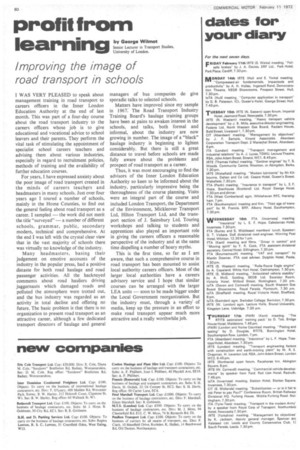profit from learning
Page 62

If you've noticed an error in this article please click here to report it so we can fix it.
Improving the image of road transport in schools
I WAS VERY PLEASED to speak about management training in road transport to careers officers in the Inner London Education Authority at the end of last month. This was part of a four-day course about the road transport industry to the careers officers whose job is to give educational and vocational advice to school leavers and their parents. They perform the vital task of stimulating the appointment of specialist school careers teachers and advising them about various industries, especially in regard to recruitment policies, methods of training and the availability of further education courses.
For years, I have expressed anxiety about the poor image of road transport created in the minds of careers teachers and headmasters in many schools. Just over four years ago I toured a number of schools, mainly in the Home Counties, to find out the general feeling about road transport as a career. I sampled the work did not merit the title "surveyed" -a number of different schools, grammar, public, secondary modern, technical and comprehensive. At the end I was left with the crystal clear view that in the vast majority of schools there was virtually no knowledge of the industry.
Many headmasters. basing their judgement on emotive accounts of the industry in the popular press, had a positive distaste for both road haulage and road passenger activities. All the hackneyed comments about road hauliers driving juggernauts which damaged roads and polluted the atmosphere were trotted out, and the bus industry was regarded as an activity in total decline and offering no future. The basic problem is that there is no organization to present road transport as an attractive career, although a few dedicated transport directors of haulage and general managers of bus companies do give sporadic talks to selected schools.
Matters have improved since my sample in 1967: The Road Transport Industry Training Board's haulage training groups have been at pains to awaken interest in the schools, and talks, both formal and informal, about the industry are now growing in number. The image of a "black" haulage industry is beginning to lighten considerably. But there is still a great distance to travel before schools are made fully aware about the problems and prospect of road transport as a career.
Thus, it was most encouraging to find the advisors of the Inner London Education Authority so keen to be informed about the industry, particularly impressive being the thoroughness of the course planning. Visits were an integral part of the course and included London Transport, the Department of the Environment, Mickleover Transport Ltd, Hilton Transport Ltd, and the transport section of J. Sainsbury Ltd. Touring workshops and talking to students and apprentices also played an important role in giving the careers officers a reasonable perspective of the industry and at the same time dispelling a number of hoary myths.
This is the first time, so far as I am aware, that such a comprehensive course in road transport has been mounted to assist local authority careers officers. Most of the larger local authorities have a careers advisory service and I hope that similar courses can be arranged with the larger LEA units soon to be made bigger under the Local Government reorganization. But the industry must, through a variety' of media, keep up the pressure in an effort to make road transport appear much more attractive and a really worthwhile job.








































































































